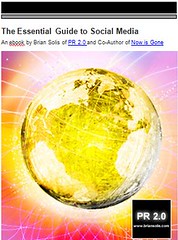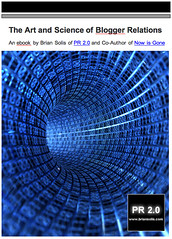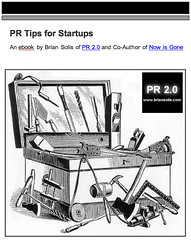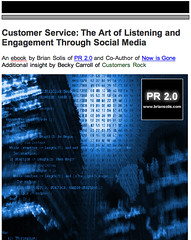Further Defining Social Media Releases

Duncan Riley, whom I greatly admire and respect, offered a very enlightening response to a recent question posed concerning the distribution of Social Media Releases on Gooruze, a new social network dedicated to helping marketing, advertising, search, and PR professionals learn, share and grow together. Disclosure, Duncan and I are among the eight founding "gooruze."
His points are very important and worth sharing as they will make us "think" about how, when, where, and why to use social media releases, if at all.
As much as I respect and understand where Brian is coming from, I can’t help but think that Social Media Release is a non-term. The whole point of social media is that it doesn't conform to traditional rules, and media releases are one of these things; social in this case representing of and from the people. There's still a strong place for media releases - and people should always send them to me, particularly first ;) - but you can't use media releases in a medium that has no center, and is decentralized as part of its very nature. The key is getting in the back door: you wouldn't send a press release to Digg, but you can get on Digg by using more traditional PR methods by contacting the right person at the right blog.
My reply:
Duncan, your views accurately capture the challenges associated with this new format. Well said.
I agree that the SMR is not so much a non-term, but definitely a misunderstood tool, which I’m sure, took off well beyond the original aspirations of SMR creator Todd Defren. Perhaps it’s propelled by the fact that people want so desperately to save or leapfrog the press release, that they are pinning their hopes on this new format.
I can’t agree with you more…Social Media doesn’t conform to traditional rules and is driven by and for the people. This is such an important point because there are many people who believe that the SMR is the only way to engage in conversations, when we all know, that only direct participation is the only way to engage.
Perhaps I need to do a better job in contributing to the value of SMRs.
In the past, I’ve written SMRs to complement media/blogger relations, traditional press releases, as well as corporate blog posts. I’ve placed them online using a social platform, such as Wordpress, and placed them inside of a socially-enabled press room – also built on Wordpress, as an extension to a company Web site. In these cases, they’ve had some pretty interesting and encouraging results.
I haven’t yet though, used Social Media Releases to distribute news to bloggers and journalists. I don’t see the need to replace relationships with “new” tools, and I hope that others don’t forget the importance of one-on-one conversations to share news.
Fortunately or unfortunately, the momentum for the Social Media Release is picking up inertia and I am spending quite a bit of free time (whatever I have these days) adding to the collective voices out there to help clarify what they are, what they aren’t, and also how they may help.
The SMR started as a way of putting together the information that writers need, in one place, collecting the building blocks of any good news story, including news facts, images, video, RSS feeds, links to supporting market information, links to social networks and bookmarks, and also suggested tags, all without the usual BS or spin.
Somewhere along the way, perhaps just over a year ago, some of us discussed the possibility of renaming the Social Media Release as the New Media Release as to not confuse people between the tools to reach people versus the networks where conversations take place with or without PR. But since the Social Media Release brand has legs that only seem to be gaining momentum, I’m committed to helping guide their use and benefits on a path of relevance.
You’re exactly right, “You can't use media releases in a medium that has no center, and is decentralized as part of its very nature.”
I couldn’t have said it any better.
SMRs or New Media Releases were never intended to become the hub, but they were designed to provide information and hopefully, also spark conversations by placing information in places where the content could be discovered – directly and indirectly. Most importantly, they were not intended to cure the ills of many traditional press releases nor are they designed to replace them. They do however, represent an opportunity to distribute information in a usable way, while also presenting the information within social networks to enable people to disseminate, discuss, share, and also provide perspective.
The landscape for good press releases is broadening and is forcing PR to think about new ways to write and distribute them thanks to search engines and meme tracking services ala Techmeme. 51% of IT professionals for example, claim to get their news directly from the press releases that show up in Yahoo Business or Google News over traditional industry rags. And, depending on the day, PRNewswire and Businesswire are now ranked within the top 50 sources in Techmeme’s Leaderboard. It’s all very interesting to say the least. It is also very revealing.
What I’ve learned is that it’s now more important than ever to package news in a useful and meaningful format using the channels where the people you want to reach go for their information.
However, none of this alleviates the need to share news with the people who can help carry information to the people you want to ultimately reach. In the realm of blogger and media relations, relationships are the foundation for distributing information. And in this case, press releases are merely an option – as long as the news and appropriate information is shared in a way that meets the needs of each blogger/reporter.
Social Media is about people. A Social Media Release simply can’t be the only solution for bridging conversations between people and companies though. It can however, present information through social channels which “can” empower people to do more with the content that they discover. But at the very least, SMRs are forcing PR people how to do things better, differently, and hopefully, more effectively.
Additional reading:
The Future of the Social Media Release is in Your Hands - Use it responsibly
Connect on Twitter, Jaiku, Pownce or Facebook.
social+media socialmedia smr social+media+release social media release media+20 media2.0 2.0 press+release pressrelease pr pr2.0 pr+20 todd+defren template brian+solis hrelease media+release press publicity communications marketing duncan+riley techcrunch public+relations public relations blogger+relations blogger blog












2 Comments:
Many PR people are now working in a "knee-jerk" reactionary way since the publication of "Die, Press Release, Die". Yet they encounter obstacles if they are part of corporate communications because they are unable to just go out "do it". They have to educate leadership, persuade IT to help them, the list goes on and on in an annoying manner. Are you saying PR people should send a traditional release to a targeted (and well-researched) audience and then if possible, create a social media news center on the company web site?
FYI - Something went wrong with my original post. I'm not cpr, I'm swcellura.
Post a Comment
<< Home